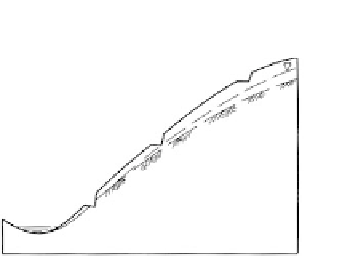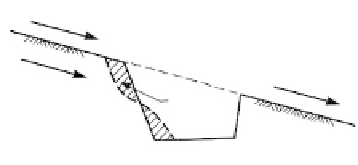Environmental Engineering Reference
In-Depth Information
FIGURE 9.87
Upslope side of hillside cut tends to be much less stable
than downslope side because of runoff and seepage.
Road
way
At cut 3:
Slope less steep and less runoff
deepwr soil cover; no collivium
deeper GWL
At cut 1:
Steep slope
thin cover with colluvium
high GWL and runoff
possible river erosion
Cut 3
Cut 2
FIGURE 9.88
Stability problems may be very much related to the
cut location along a steeply inclined slope in
mountainous terrain in a tropical climate, and
generally decrease in the upslope direction.
Cut 1
River
regional climatic history. No slope seepage during a rainy period may be considered as
very favorable for stability, if there is no blockage from ice, colluvium, etc. On the other
hand, seepage during a dry period signifies that a substantial increase in seepage will
occur during wet periods. Toe seepage indicates a particularly dangerous condition, espe-
cially during dry periods.
Vegetation
Density of vegetation is an important factor in slope stability. Recently cleared upslope
areas for logging, farming, or grazing are very likely to be locations where failures will
occur in freshly made cuts, or in old cuts during severe weather conditions. Removal of
vegetation permits an increase in erosion, a reduction in strength in the shallow portions
of the slope from the loss of root structure, an increase in infiltration during rainy periods,
and an increase in evaporation during dry spells resulting in surface desiccation and
cracking.
Certain types of vegetation may be indicators of potential instability. For example, in
tropical climates, such as in Brazil and Indonesia, banana plants seem to favor colluvial
soil slopes, probably because colluvium has a higher moisture content than the residual
soils in the same area.
Indications of Instability
Surface features indicating instability include tilted or bending tree trunks, tilted poles
and fence posts, tension cracks along the slope and beyond the crest, and slump and
hummocky topography, as described and illustrated in
Sections 9.1.2
and
9.2.
Slope Activity
Degrees of Activity
Slopes reside at various degrees of activity, as discussed in Section 9.1.2, ranging through
stable slopes with no movement, early failure stages with creep and tension cracks,



